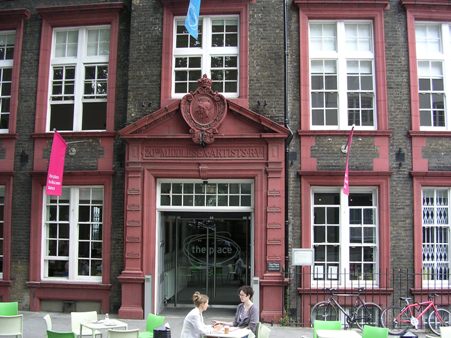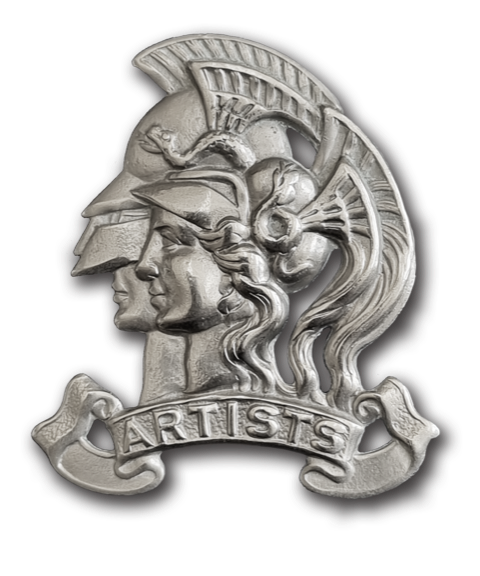The 38th Middlesex Volunteer Rifle Corps (Artists) was raised by artist Edward Sterling on 10th May 1860 as part of the volunteer movement which arose over concerns about a possible French invasion. The 38th was composed of painters, sculptors, engravers, musicians, architects and actors. The artists predominated and the Corps soon became known as the Artists Rifles.
The badge of the new regiment is believed to be the design of James Wyon, Resident Engraver at the Royal Mint. It shows the heads of the Roman gods Mars and Minerva in profile. Wyon was one of a family of engravers, many of whom served in the Artists. The full dress uniform was light grey with white facings, silver buttons and braid.
The regiment had very strong links with the Royal Academy from their earliest days. For the first eight years their headquarters was at Burlington House. Many of the volunteers were also associated with the Royal Academy. Five members were elected President of the Royal Academy; at least 41 were elected Royal Academicians and 8 became Associates of the Royal Academy.
Some of the better-known early members were Edward Burne-Jones, William Morris, John Everett Millais, Frederick Leighton, William Holman Hunt and George Frederic Watts.

In September 1880, the corps was renumbered and became the 20th Middlesex (Artists’) Rifle Volunteer Corps. In 1888 it moved into its new headquarters at Duke’s Road, off Euston Road, London (now The Place, home of the Contemporary Dance Trust). The drill hall was paid for by its members and designed by Robert William Edis, the commanding officer.
By the 1890s the composition of the corps had broadened to include professions beyond the Arts. Lawyers and architects made up 24% of the unit, doctors followed with 10% and civil engineers 6%. Sculptors and painters totalled about 5%. The Artists Rifles was essentially a middle class unit that tended to attract recruits from public schools and universities.
During the Second Boer War of 1900-1902 all London Volunteer units were required to provide one officer and forty men to serve in a mixed unit called the City of London Imperial Volunteers (or C.I.V.). Nearly 60 Artists volunteered, and many others transferred to other units so as to have a chance to serve in South Africa.
With the formation of the Territorial Force in April 1908 the unit was renumbered once more, becoming the 28th (County of London) Battalion of The London Regiment.

(now The Place, home of the Contemporary Dance Trust)
World War I and World War II
With the outbreak of WW1, the Artists were mobilised in August 1914 and deployed that October to Bailleul in France. Within days nearly 50 other ranks were selected to serve as officers in other units of the 7th Division, an exercise so successful that early in 1915 the regiment established an Officers Training Corps in France run by Artists officers and NCOs. Having experience of machine guns, they also provided instructors for a Machine Gun Training School before the establishment of the Machine Gun Corps.
The 1st Battalion served as a guard battalion at BEF General Headquarters in St Omer and Montreuil-sur-Mar until June 1917, when it was transferred to the 63rd (Royal Naval) Division. They saw action with the RND at Passchendaele in the 3rd Battle of Ypres, in the Cambrai sector during the winter of 1917-18, during the German Spring Offensive of 1918 and the final British advance in the Hundred Days campaign. At the end of the war the battalion was just outside Mons. Their action at Welsh Ridge at Marcoing on 30th December 1917 is depicted in the iconic WWI painting ‘Over the Top’, by John Nash, who took part in the attack as a corporal.

A 2nd Battalion was formed in England at Hare Hall at Gidea Park in Essex. This also trained officers and became the basis of No 15 Officer Cadet Battalion. In all, during WWI, 10,256 officers were commissioned after training with the Artists Rifles. They went to the Foot Guards, every infantry regiment and to many of the Corps. The Royal Artillery alone had 953 officers and the London Regiment 738 officers commissioned from the Artists Rifles. A number also went into the Royal Navy and Royal Flying Corps. Men commissioned from the Artists Rifles were awarded more than 1000 medals for gallantry. See Roll of Honour.
The Artists Rifles were revived as an infantry unit when the Territorial Army was reformed in 1920. By the 1930s they formed part of an officer-producing group with the HAC and Inns of Court when a number of Artists were also commissioned into the Royal Air Force. The Artists continued their success in Skill at Arms at the Royal Tournament and produced a number of Olympians.
On mobilization in September 1939 the battalion formed the basis of 163 Officer Cadet Training Unit and most of the other ranks were commissioned into other regiments and corps. 164 OCTU was later organized from this unit, but the Artists connection disappeared. There was no Artists Rifles unit as such during the Second World War and there are no official records of Artists casualties or decorations awarded to former Artists.
The Regiment Today
At the end of World War II, 1st and 2nd S.A.S. were officially disbanded, amid high level debate in Whitehall questioning the need for any special forces capability in peace time. From late 1945, Colonel B. M. F. Franks, D.S.O., M.C., T.D. was in constant negotiation with the War Office (MoD) to ensure that the effective capability of an S.A.S. Regiment would not disappear.
A compromise was finally reached; the Artists Rifles would be renamed as 21st Special Air Service (Artists) Volunteers. This meant that special forces had a place in the Territorial Army and more importantly the British Armed Forces.

Franks was appointed as the first C.O. of 21 S.A.S. on 1 May 1947. Officially he was permitted to recruit from former personnel from the Parachute Regiment and the Rifle Brigade but he also recruited from the S.A.S. Regimental Association as well as the special duties community, men who had served in wartime with MI6, Special Operations Executive and other special forces.
The traditions of the Artists Rifles were firmly established within the re-formed S.A.S. Regiment. Pre-war Artists joined ‘A’ Squadron or HQ Troop and were commanded and trained by highly experienced wartime S.A.S. officers and N.C.O.s. Importantly, Franks also intended the regiment to have a Special Boat (or S.B.S.) capability and this is why S.B.S. veterans such as Lt Col Ian Lapraik D.S.O. were also recruited to help form the first boat troop. This later became “B” Squadron.
Personnel were to be trained in the tradition of the wartime S.A.S. in how to operate as small parties behind the enemy lines. The Artists Rifles Association kindly provided the funds to acquire specialist signals equipment used by the S.A.S. for communications.
Brian Franks died in his sleep on 6 May 1982. Undoubtedly, he was the founding father of today’s S.A.S. Regiments. To quote Dare Newell in 1982; “Without his wisdom, his charm, his drive and vitality, there would be no S.A.S. today. We owe him almost everything.”
Those interested in joining the S.A.S. reserve;
www.army.mod.uk/who-we-are/corps-regiments-and-units/uk-special-forces-reserve/21-23-sas-r/


